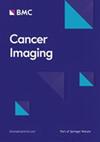The utility of 18F-FDG PET/CT for predicting the pathological response and prognosis to neoadjuvant immunochemotherapy in resectable non-small-cell lung cancer
IF 3.5
2区 医学
Q2 ONCOLOGY
引用次数: 0
Abstract
To evaluate the potential utility of 18F-FDG PET/CT to assess response to neoadjuvant immunochemotherapy in patients with resectable NSCLC, and the ability to screen patients who may benefit from neoadjuvant immunochemotherapy. Fifty one resectable NSCLC (stage IA–IIIB) patients were analyzed, who received two-three cycles neoadjuvant immunochemotherapy.18F-FDG PET/CT was carried out at baseline(scan-1) and prior to radical resection(scan-2). SULmax, SULpeak, MTV, TLG, T/N ratio, ΔSULmax%,ΔSULpeak%, ΔMTV%, ΔTLG%,ΔT/N ratio% were calculated. 18F-FDG PET/CT responses were classified using PERCIST. We then compared the RECIST 1.1 and PERCIST criteria for response assessment.With surgical pathology of primary lesions as the gold standard, the correlation between metabolic parameters of 18F-FDG PET/CT and major pathologic response (MPR) was analyzed. All metabolic parameters were compared to treatment response and correlated to PFS and OS. In total of fifty one patients, MPR was achieved in 25(49%, 25/51) patients after neoadjuvant therapy. The metabolic parameters of Scan-1 were not correlated with MPR.The degree of pathological regression was negatively correlated with SULmax, SULpeak, MTV, TLG, T/N ratio of scan-2, and the percentage changes of the ΔSULmax%, ΔSULpeak%, ΔMTV%,ΔTLG%,ΔT/N ratio% after neoadjuvant therapy (p < 0.05). According to PERCIST, 36 patients (70.6%, 36/51) showed PMR, 12 patients(23.5%, 12/51) had stable metabolic disease(SMD), and 3 patients(5.9%, 3/51) had progressive metabolic disease (PMD). ROC indicated that all of scan-2 metabolic parameters and the percentage changes of metabolic parameters had ability to predict MPR and non-MPR, SULmax and T/N ratio of scan-2 had the best differentiation ability.The accuracy of RECIST 1.1 and PERCIST criteria were no statistical significance(p = 0.91). On univariate analysis, ΔMTV% has the highest correlation with PFS. Metabolic response by 18F-FDG PET/CT can predict MPR to neoadjuvant immunochemotherapy in resectable NSCLC. ΔMTV% was significantly correlated with PFS.18F-FDG PET/CT 对可切除非小细胞肺癌新辅助免疫化疗病理反应和预后的预测作用
评估18F-FDG PET/CT在评估可切除NSCLC患者对新辅助免疫化疗反应方面的潜在作用,以及筛选可能从新辅助免疫化疗中获益的患者的能力。研究分析了51例可切除NSCLC(IA-IIIB期)患者,这些患者接受了2-3个周期的新辅助免疫化疗。18F-FDG PET/CT在基线(扫描-1)和根治性切除术前(扫描-2)进行。计算SULmax、SULpeak、MTV、TLG、T/N比值、ΔSULmax%、ΔSULpeak%、ΔMTV%、ΔTLG%、ΔT/N比值。使用 PERCIST 对 18F-FDG PET/CT 反应进行分类。然后,我们比较了 RECIST 1.1 和 PERCIST 的反应评估标准。以原发病灶的手术病理为金标准,分析了 18F-FDG PET/CT 代谢参数与主要病理反应(MPR)之间的相关性。所有代谢参数都与治疗反应进行了比较,并与PFS和OS相关。在51例患者中,25例(49%,25/51)患者在新辅助治疗后达到了MPR。病理消退程度与扫描-2的SULmax、SULpeak、MTV、TLG、T/N比值以及新辅助治疗后ΔSULmax%、ΔSULpeak%、ΔMTV%、ΔTLG%、ΔT/N比值%的百分比变化呈负相关(P<0.05)。根据 PERCIST,36 例患者(70.6%,36/51)表现为 PMR,12 例患者(23.5%,12/51)为稳定代谢病(SMD),3 例患者(5.9%,3/51)为进展代谢病(PMD)。ROC表明,扫描-2的所有代谢参数和代谢参数的百分比变化都具有预测MPR和非MPR的能力,扫描-2的SULmax和T/N比值具有最好的分辨能力,RECIST 1.1和PERCIST标准的准确性无统计学意义(P = 0.91)。在单变量分析中,ΔMTV%与PFS的相关性最高。18F-FDG PET/CT 代谢反应可预测可切除 NSCLC 新辅助免疫化疗的 MPR。ΔMTV%与PFS有明显相关性。
本文章由计算机程序翻译,如有差异,请以英文原文为准。
求助全文
约1分钟内获得全文
求助全文
来源期刊

Cancer Imaging
ONCOLOGY-RADIOLOGY, NUCLEAR MEDICINE & MEDICAL IMAGING
CiteScore
7.00
自引率
0.00%
发文量
66
审稿时长
>12 weeks
期刊介绍:
Cancer Imaging is an open access, peer-reviewed journal publishing original articles, reviews and editorials written by expert international radiologists working in oncology.
The journal encompasses CT, MR, PET, ultrasound, radionuclide and multimodal imaging in all kinds of malignant tumours, plus new developments, techniques and innovations. Topics of interest include:
Breast Imaging
Chest
Complications of treatment
Ear, Nose & Throat
Gastrointestinal
Hepatobiliary & Pancreatic
Imaging biomarkers
Interventional
Lymphoma
Measurement of tumour response
Molecular functional imaging
Musculoskeletal
Neuro oncology
Nuclear Medicine
Paediatric.
 求助内容:
求助内容: 应助结果提醒方式:
应助结果提醒方式:


